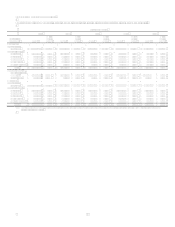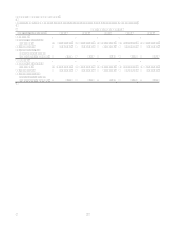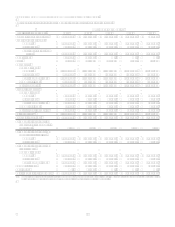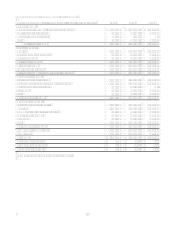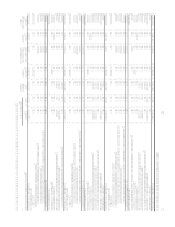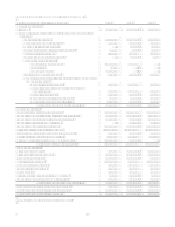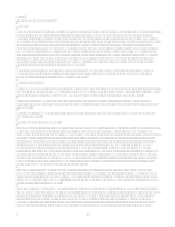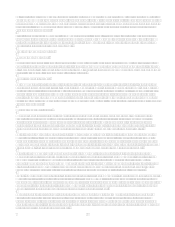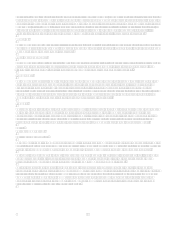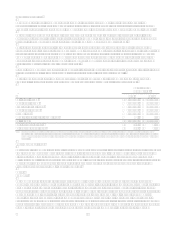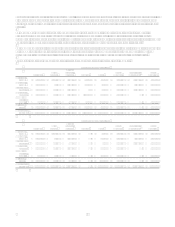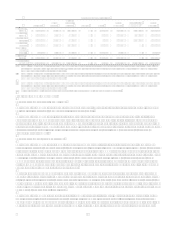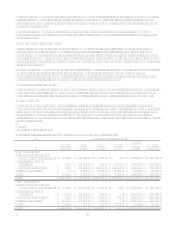Capital One 2006 Annual Report Download - page 89
Download and view the complete annual report
Please find page 89 of the 2006 Capital One annual report below. You can navigate through the pages in the report by either clicking on the pages listed below, or by using the keyword search tool below to find specific information within the annual report. 71
January 1, 2007, the Company has adopted the provisions of FIN 48; however, management is still evaluating the impact of
adoption of FIN 48 on the financial position and results of operations of the Company.
In March 2006, the FASB issued Statement of Financial Accounting Standard No. 156, Accounting for Servicing of Financial
Assets-an amendment of FASB Statement No. 140, (SFAS 156). SFAS 156 amends FASB Statement No. 140, Accounting
for Transfers and Servicing of Financial Assets and Extinguishments of Liabilities, (SFAS 140), with respect to the
accounting for separately recognized servicing assets and servicing liabilities. SFAS 156 requires an entity to recognize a
servicing asset or servicing liability each time it undertakes an obligation to service a financial asset by entering into a
servicing contract in certain situations prescribed by SFAS 156. All separately recognized servicing assets and servicing
liabilities are to be initially measured at fair value, if practicable, and SFAS 156 permits an entity to choose either the
amortization method or fair value measurement method for subsequent measurement methods for each class of separately
recognized servicing assets and servicing liabilities. SFAS 156 is effective as of the beginning of an entitys first fiscal year
that begins after September 15, 2006. The requirements for recognition and initial measurement of servicing assets and
servicing liabilities should be applied prospectively to all transactions after the effective date of this statement. As of
January 1, 2007, the Company adopted SFAS 156 and elected to measure its servicing assets and servicing liabilities using
the fair value measurement method. The Company has identified mortgage servicing rights (MSRs) relating to residential
mortgage loans as a single class of servicing rights and has elected to apply fair value accounting to these MSRs. Presently,
this class represents all of the Companys material servicing rights. The adoption of SFAS 156 did not have a material impact
on the consolidated earnings or financial position of the Company.
In February 2006, the Financial Accounting Standards Board (FASB) issued Statement of Financial Accounting Standard
No. 155, Accounting for Certain Hybrid Financial Instruments-an amendment of FASB Statements No. 133 and 140, (SFAS
155). SFAS 155 amends FASB Statements No. 133, Accounting for Derivative Instruments and Hedging Activities, (SFAS
133) and No. 140, Accounting for Transfers and Servicing of Financial Assets and Extinguishments of Liabilities, (SFAS
140). SFAS 155 resolves issues addressed in SFAS 133 Implementation Issue No. D1, Application of Statement 133 to
Beneficial Interests in Securitized Financial Assets. SFAS 155 permits fair value remeasurement for any hybrid financial
instrument that contains an embedded derivative that otherwise would require bifurcation, clarifies which interest-only strips
and principal-only strips are not subject to the requirements of SFAS 133, establishes a requirement to evaluate interests in
securitized financial assets to identify interests that are freestanding derivatives or that are hybrid financial instruments that
contain an embedded derivative requiring bifurcation, clarifies that concentrations of credit risk in the form of subordination
are not embedded derivatives, and amends SFAS 140 to eliminate the prohibition on a qualifying special-purpose entity from
holding a derivative financial instrument that pertains to a beneficial interest other than another derivative financial
instrument. SFAS 155 is effective for all financial instruments acquired or issued after the beginning of an entitys first fiscal
year that begins after September 15, 2006. The adoption of SFAS 155 did not have a material impact on the consolidated
earnings or financial position of the Company.
In May 2005, the FASB issued Statement of Financial Accounting Standard No. 154, Accounting Changes and Error
Correctionsa replacement of APB Opinion No. 20 and FASB Statement No. 3, (SFAS 154). SFAS 154 changes the
requirements for the accounting for and reporting of a change in accounting principle. SFAS 154 applies to all voluntary
changes in accounting principle and to changes required by an accounting pronouncement in the unusual instance that the
pronouncement does not include specific transition provisions. SFAS 154 is effective for accounting changes and corrections
of errors made in fiscal years beginning after December 15, 2005. The Company will apply the provisions of SFAS 154 when
applicable in future reporting periods.
Effective January 1, 2006, the Company adopted the fair value recognition provisions of SFAS 123(R) using the modified-
prospective-transition method. Under that transition method, compensation cost recognized during the year ended
December 31, 2006 includes: (a) compensation cost for all share-based payments granted prior to, but not yet vested as of
January 1, 2006, based on the grant date fair value estimated in accordance with the original provisions of SFAS 123, and
(b) compensation cost for all share-based payments granted subsequent to January 1, 2006, based on the grant-date fair
valued estimated in accordance with the provisions of SFAS 123(R). The Company voluntarily adopted the expense
recognition provisions of Statement of Financial Accounting Standard No. 123, Accounting for Stock Based Compensation
(SFAS 123), prospectively to all awards granted, modified, or settled after January 1, 2003. Prior to January 1, 2003, the
Company applied Accounting Principles Board Opinion No. 25, Accounting for Stock Issued to Employees and related
Interpretations in accounting for its stock based compensation plans. Results for prior periods have not been restated.
The Company has two active stock-based compensation plans, one employee plan and one non-employee director plan,
which are described more fully in Note 10. Under these plans, the grants to retirement eligible associates continue to vest
after the associate retires. For awards granted prior to the adoption of SFAS 123(R), the Company had been and will continue
to recognize the compensation cost of those awards over the full vesting periods or up to the date of retirement.


